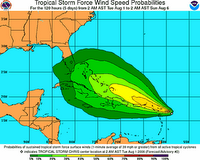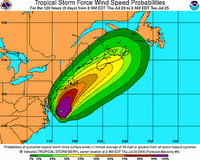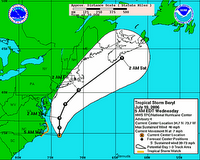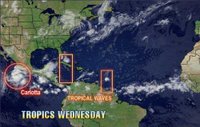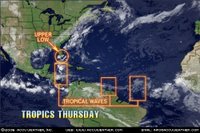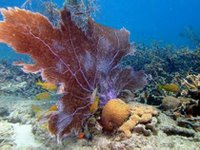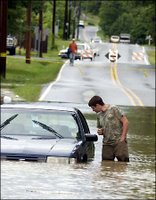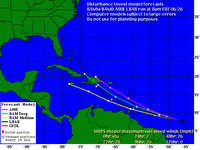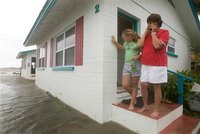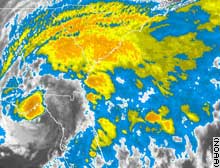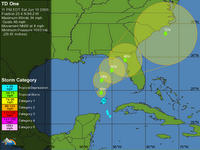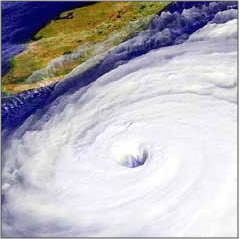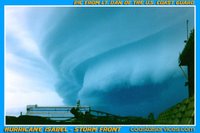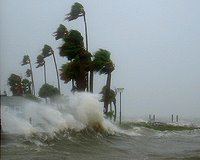
At 5:00 a.m., EDT, Tuesday, the center of Tropical Storm Ernesto was located near 22.6 north and 78.9 west. It is just off the Cuban shoreline and is about 235 miles south-southeast of Miami, Florida, with maximum sustained winds of 45 mph. Ernesto was moving to the northwest at near 14 mph. The surface pressure is 1005 millibars or 29.68 inches.
A tropical storm warning and hurricane watch is in effect for the southern Peninsula of Florida from New Smyrna Beach southward on the east coast, and from Bonita Beach southward along the west coast. A tropical storm watch is in effect from Bonita Beach northward to Englewood on the Florida west coast. A tropical storm warning and hurricane watch also remains in effect for Lake Okeechobee and all of the Florida Keys from Ocean Reef to the Dry Tortugas. A tropical storm warning and hurricane watch also remains in effect for Anddros Island in the northwestern Bahamas, the Biminis and Grand Bahama Island. A tropical storm warning remains in effect for the Cuban provinces of Guantanamo, Santiago de Cuba, Granma, Holguin, Las Tunas and Camaguey and the Ragged Islands and Great Exuma Island in the central Bahamas.
As of Tuesday morning, Ernesto was just off the Cuban coastline on the eastern side of the island. The storm has been interacting with the 4,000-foot mountains of eastern Cuba and a weak upper-level low just southeast of Miami, Florida. This has caused the lower-level circulation around the storm to become poorly organized, and the upper-level low has fed drier air into the system causing thunderstorms to be even more disorganized. An Air Force Hurricane Hunter aircraft reported estimated surface winds of near tropical storm strength just of the northeastern Cuban coast during the late afternoon and evening hours of Monday. So the system remains a very weak tropical storm. Although surface reports over northeastern Cuba show nothing near tropical storm strength. We expect the lower-level circulation to redevelop along or just off shore of the northern Cuban coast this morning and into this afternoon. As the lower-level part of this system gets back over water, it should start to organize and strengthen again. The broader circulation around the storm will continue to interact with Cuba through Tuesday morning and that will limit how strong the system can become initially. However, once the system becomes better organized in the lower levels, the upper levels should shift away from Cuba due to the light upper-level winds. Once the entire system is over water, which will be around midday or early afternoon Tuesday, there is a good chance it will continue to strengthen. However, due to the long lasting encounter with land there is only a small chance Ernesto can become a hurricane before reaching the south Florida coast later Tuesday night. Ernesto will track west-northwest then more northwest during Tuesday. That will put the storm's center just south of Marathon Florida in the central Keys Tuesday evening.
An oval-shaped, upper-level high pressure area is currently located over the Southeast U.S. and northern Florida. This ridge will weaken and move eastward as a strong upper-level system moves east from the Plains. That upper-level trough has turned out to be much stronger and is moving faster than thought a few days ago. That is why the forecasted movement of Ernesto has changed so much over the past three days. The upper-level high is expected to weaken slowly and move east slowly today. This will allow Ernesto to move into South Florida late Tuesday night between Miami and Key West and move northward through the peninsula during the day Wednesday. This will lead to rain and thunderstorms over South Florida tonight and over central and South Florida during Wednesday and early Wednesday night.
Ernesto is expected to make a second United States landfall, along the Carolina coastline Friday. Ernestos will bring heavy rainfall to the northern Carolinas into the Virginias and toward the Northeast later this week.



